Alcohol. It is without question one of the major elements of a successful wedding reception. While unique nuptial cocktails are very much the rage; the fact is a lot of venues accommodate only wine, beer, and champagne. The element of specialization, however, continues to ever-grow, thanks to DIY millennials and any couple looking to add a touch of distinction to a wedding toast. Don’t feel that you are limited when offering beer or wine; look to shrubs, bitters, and edible flowers to make familiar drinks wholly different. Let’s have a look.
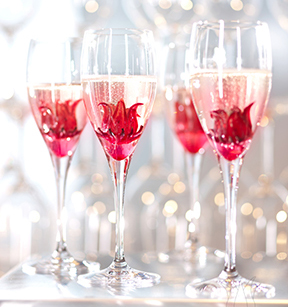
Better bitters
Of the many drink additives and enhancements, bitters are probably the most recognizable, predominantly when used with craft cocktails. An alcoholic preparation flavored with botanical matter, a bitters’ end result is characterized by a sour, bitter, or bittersweet flavor. Angostura bitters, with its distinctive oversized label, is probably the most recognizable of the bunch and is a key component of the classic Manhattan cocktail. But take a look around you—the market for bitters is ever expanding, with new players entering the field from coast-to-coast. From celery bitters (which we wouldn’t necessarily recommend as an addition to your favorite champagne) to fruity orange and cherry (which we absolutely would) to chocolate or lemon (how great does that sound for a favorite beer?), the possibility for enhancing a beer or wine with bitters is almost limitless.
Michelada
There are several variations on this beer cocktail, but the addition of bitters—and a fun garnish—will elevate the regular beer to new heights.
Yield: one
Ingredients & method
Lime wedge
Margarita salt
Tajin seasoning
Pint glass
Combine equal parts of salt and Tajin. Rub three-quarters of the glass edge lightly with the lime and then dip into the salt/seasoning mixture.
.5 oz fresh lime juice
2 drops Tabasco
2 dashes Worcestershire sauce
1 bottle Mexican lager, such as Pacifico or Tecate
2 dashes celery bitters (I prefer Scrappy’s)
Add first three ingredients into the dipped glass, fill with beer, add the bitters to the top, and garnish with a lime wheel. —Kathleen Stoehr
Sensational shrubs
Growing in popularity are shrubs: sweetened vinegar-based syrups. “A shrub is an acidulated beverage, which simply means it’s a drink like lemonade—a drink with an acidic ingredient,” says Michael Dietsch, author of Shrubs: An Old Fashioned Drink for Modern Times. “In shrubs, that ingredient is vinegar, which was initially used to preserve fruit juice well past the harvest. Today, we use it because it’s delicious.”

Shrubs, only re-emerging behind the bar within the past couple of years, are complex, multi-layered ingredients that offer a lot of nuance. “Citrus is great in certain cocktails,” says Dietsch, “but it can be a little one-note, adding only tartness and a hint of flavor. Shrubs [will] also add tartness, but they also bring more flavor to a drink. They’re great as the base of non-alcoholic drinks, too.”

While shrubs are currently de rigueur for cocktails, Dietsch says they also have plenty of utility for wine, beer, and champagne. “A festive, fruity shrub is perfect for a wedding,” he says. “Berry shrubs especially provide bright colors that look great in a glass. I haven’t done a lot with beer and shrub, though if you select a really hoppy [beer], you might find that the bitterness of the beer clashes with the tart shrub. Crisp lagers are good [choices], and also farmhouse ales.
“White wines and champagnes go very well with shrubs. I have a recipe in my book for Kir and Kir Royale, in which I pair shrub with white wine (in the case of Kir) and champagne (in the case of the Royale). Red wine also works, especially in a shrub-spiked sangria.”
While some bartenders may be unfamiliar with using a shrub in a beverage, Dietsch said it should be of no real concern. “If you’re starting with a prepared or a commercial shrub, it’s pretty easy to mix drinks with them,” he says. “Even making the shrubs themselves is pretty straightforward, which means you can control the quality of the final product. The few commercial shrubs on the market are generally pretty good, however.” One example is Shrub & Co., out of Berkeley, CA. Sixteen-ounce bottles of shrub retail between $22 to $24 with a typical recipe calling for no more than three-quarters of an ounce per beverage (such as with its suggested Shrub Bellini with 3 to 4 oz sparkling wine, .75 oz peach shrub, and an optional .25 fresh lemon juice).
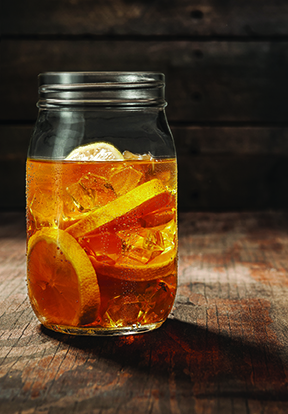
Martha Washington’s Shrub
This recipe for shrub comes from a handwritten book (Martha Washington’s Booke of Cookery) that Martha inherited from her first mother-in-law, Frances Parke Custis. The book was handed down through the generations, originating probably in England in the early 1600s. Martha herself held onto it for 50 years, before handing it down to her granddaughter Eleanor Parke Custis, on the occasion of Eleanor’s marriage. In 1981, a food historian named Karen Hess transcribed and annotated the handwritten book for Columbia University Press. The Hess edition is still in print. —Michael Dietsch
Ingredients
1 750 ml cognac
1 750 ml dry white wine (such as a pinot gris)
3 cups bottled spring water
2 lemons, sliced and crushed, with the rinds
1-1/2 cups turbinado or demerara sugar
Method
1. Add all ingredients to a large pot, stirring well. Let it sit for several days, stirring every day, until the sugar dissolves.
2. Strain the lemon remains using a fine mesh strainer lined with cheesecloth.
3. Bottle it and store, preferably in the refrigerator.
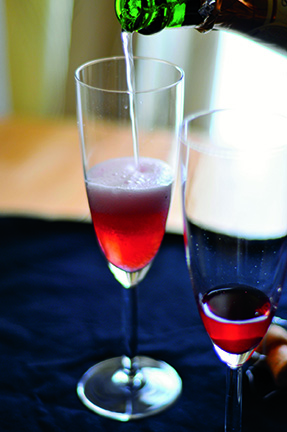
For a Kir: Pour a half ounce of the couple’s favorite shrub into a wine glass or flute and top with 3 to 4 oz of wine or champagne.
Florals & garnishes
In addition to shrubs and bitters, wine, beer, and champagne can also be jazzed up with edible flowers, floral syrups and extracts, and fruit or herb garnishes.
Placing a curl of lemon peel into the Vesper cocktail adds visual interest and the fresh scent of citrus oil; why not place a twist into each glass of champagne? It follows then, why stop at a lemon peel? Cherries, fresh sprigs of mint or lavender, pomegranate seeds, dried citrus wheels, citrus foam, small strawberries, tiny microgreens, delicious fruit purées—there are plenty of terrific possibilities to enhance the visual appeal of a beer or wine and add a zip of unexpected flavor, allowing your happy couple to offer a signature beverage to their guests.
Edible flowers are always a welcomed and beautiful addition. While sugared flowers are eye-catching on cakes, immersion into liquid will spoil the effect. A smart, alternate option is offered by Australia’s Wild Hibiscus Flower Company, says representative Ronnie Campbell of the Burrell Group. “[It’s] a sustainable product, hand-made and hand-packed, using only three ingredients: real hibiscus sabdariffa flowers preserved in cane sugar and water. With a flavor reminiscent of blackberry, raspberry, and rhubarb, the flower has great taste along with a pliant yet firm texture.”
Examples for use include placing the flower into a champagne flute and topping with sparkling wine or champagne; or adding a touch of the syrup to the beverage, which imparts a delicate berry flavor and a pretty pink hue. “The syrup works well in beer cocktails, too,” says Campbell. For the Flor Chelada, a twist on the Michelada noted earlier in this article, fill a highball with ice, add the juice of half a lime, and three-quarters of an ounce of hibiscus syrup. Top with a favorite lager and finish with the edible flower.
Finally, who doesn’t love a colorful rim? If adding a component into a beverage is not an option, a sugar or powdered rim will enhance visual appeal. Consider using different colors for the different beverages, even, such as denoting a pinot gris from a chardonnay.
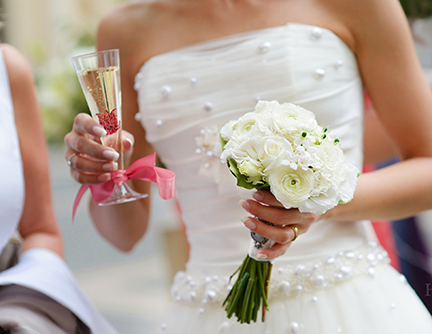
Adding a ribbon to the stem of the flute complements the hibiscus flower inside.
Garnishes galore
Zip up any beverage, alcoholic or not, with these ideas from some of the 2014 and 2015 ACE award winners and nominees.
Delicate sugar rims, skewered berries, and floating grapes offer a variety of looks | Zest Cozinha Creativa
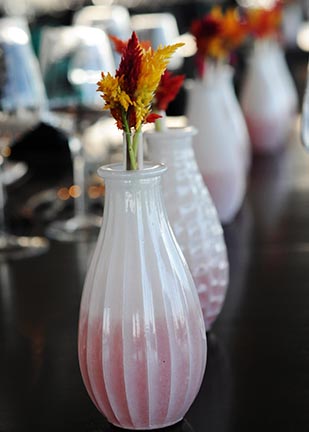
Petite bud vases are an unusual, unexpected vessel | Thomas Caterers of Distinction, Indianapolis, IN
Paper parasols and straws, gummy worms—true pops of color | Vicky Crease
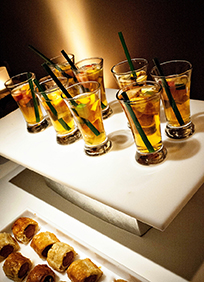
A sip paired with a bite | Feast Your Eyes
photo by Faith West Photography

Beverage sparklers | 24 Carrots
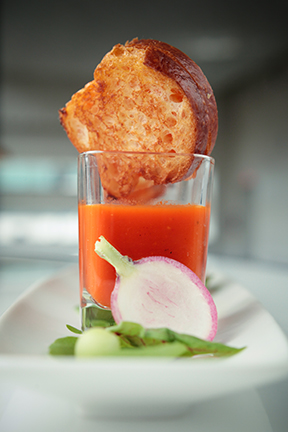
Tiny toast | Oliver & Bonacini
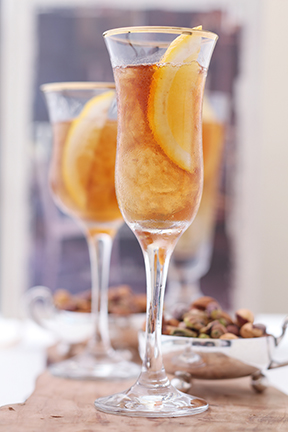
Potent Long Island punch is served in a small dose due to pretty fruit | Zest Cozinha Creativa

